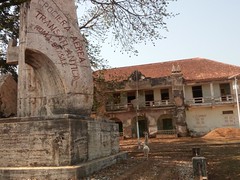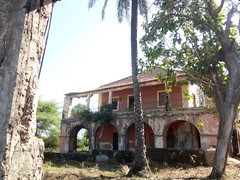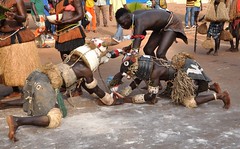Guinée-Bissau : Photos
Découvrez chaque jours des Photos des différents pays d'Afrique et des Antilles
Toutes les images proviennent du service de partage de photo flickr
Utilisez le menu de gauche pour choisir un pays.
Ambulanz mit Blaulicht überrascht uns
Das sind so die Augenblicke, wenn man entweder glaubt im falschen Film zu sein oder in eine Filmkulisse geraten zu sein. 7 km nach der Staatsgrenze zwischen Senegal und Guinea-Bissau kam uns auf einer Rumpelpiste in einem Dorf ein Krankenwagen mit Blaulicht und Sirene entgegen. Der Ambulanzfahrer hat wohl ebenso blöd wie wir geschaut, als ihm 4 Autos mit deutscher Zulassung begegnet sind.
IMG_4785
The town of Cacheu is situated in territory of the Papel people. The name is of Bainuk origin: "i.e. Caticheu, meaning 'the place where we rest'."[2]
Founded in 1588,[3] Cacheu was one of the earliest European colonial settlements in sub-saharan Africa, due to its strategic location on the Cacheu river. Cacheu developed a European/Afro-European population from the late fifteenth century through informal settlement of Cape Verdian and Portuguese traders, adventurers and outcasts (lancados). The authorities in mainland Portugal also sent to Cacheu degredados - people condemned to exile for a variety of offences.[4]
For most of the seventeenth and eighteenth centuries, Cacheu was the official slave trading point for the Portuguese in the Upper Guinea region - the point at which the Portuguese crown endeavoured to ensure that duties on all slaves exported were paid.
Notable buildings in Cacheu include the Portuguese-built 16th century fort, dating from the period when Cacheu was a centre for the slave trade.
IMG_4781
The town of Cacheu is situated in territory of the Papel people. The name is of Bainuk origin: "i.e. Caticheu, meaning 'the place where we rest'."[2]
Founded in 1588,[3] Cacheu was one of the earliest European colonial settlements in sub-saharan Africa, due to its strategic location on the Cacheu river. Cacheu developed a European/Afro-European population from the late fifteenth century through informal settlement of Cape Verdian and Portuguese traders, adventurers and outcasts (lancados). The authorities in mainland Portugal also sent to Cacheu degredados - people condemned to exile for a variety of offences.[4]
For most of the seventeenth and eighteenth centuries, Cacheu was the official slave trading point for the Portuguese in the Upper Guinea region - the point at which the Portuguese crown endeavoured to ensure that duties on all slaves exported were paid.
Notable buildings in Cacheu include the Portuguese-built 16th century fort, dating from the period when Cacheu was a centre for the slave trade.
IMG_4749
The town of Cacheu is situated in territory of the Papel people. The name is of Bainuk origin: "i.e. Caticheu, meaning 'the place where we rest'."[2]
Founded in 1588,[3] Cacheu was one of the earliest European colonial settlements in sub-saharan Africa, due to its strategic location on the Cacheu river. Cacheu developed a European/Afro-European population from the late fifteenth century through informal settlement of Cape Verdian and Portuguese traders, adventurers and outcasts (lancados). The authorities in mainland Portugal also sent to Cacheu degredados - people condemned to exile for a variety of offences.[4]
For most of the seventeenth and eighteenth centuries, Cacheu was the official slave trading point for the Portuguese in the Upper Guinea region - the point at which the Portuguese crown endeavoured to ensure that duties on all slaves exported were paid.
Notable buildings in Cacheu include the Portuguese-built 16th century fort, dating from the period when Cacheu was a centre for the slave trade.
IMG_4790
The town of Cacheu is situated in territory of the Papel people. The name is of Bainuk origin: "i.e. Caticheu, meaning 'the place where we rest'."[2]
Founded in 1588,[3] Cacheu was one of the earliest European colonial settlements in sub-saharan Africa, due to its strategic location on the Cacheu river. Cacheu developed a European/Afro-European population from the late fifteenth century through informal settlement of Cape Verdian and Portuguese traders, adventurers and outcasts (lancados). The authorities in mainland Portugal also sent to Cacheu degredados - people condemned to exile for a variety of offences.[4]
For most of the seventeenth and eighteenth centuries, Cacheu was the official slave trading point for the Portuguese in the Upper Guinea region - the point at which the Portuguese crown endeavoured to ensure that duties on all slaves exported were paid.
Notable buildings in Cacheu include the Portuguese-built 16th century fort, dating from the period when Cacheu was a centre for the slave trade.
IMG_4778
The town of Cacheu is situated in territory of the Papel people. The name is of Bainuk origin: "i.e. Caticheu, meaning 'the place where we rest'."[2]
Founded in 1588,[3] Cacheu was one of the earliest European colonial settlements in sub-saharan Africa, due to its strategic location on the Cacheu river. Cacheu developed a European/Afro-European population from the late fifteenth century through informal settlement of Cape Verdian and Portuguese traders, adventurers and outcasts (lancados). The authorities in mainland Portugal also sent to Cacheu degredados - people condemned to exile for a variety of offences.[4]
For most of the seventeenth and eighteenth centuries, Cacheu was the official slave trading point for the Portuguese in the Upper Guinea region - the point at which the Portuguese crown endeavoured to ensure that duties on all slaves exported were paid.
Notable buildings in Cacheu include the Portuguese-built 16th century fort, dating from the period when Cacheu was a centre for the slave trade.
IMG_4788
The town of Cacheu is situated in territory of the Papel people. The name is of Bainuk origin: "i.e. Caticheu, meaning 'the place where we rest'."[2]
Founded in 1588,[3] Cacheu was one of the earliest European colonial settlements in sub-saharan Africa, due to its strategic location on the Cacheu river. Cacheu developed a European/Afro-European population from the late fifteenth century through informal settlement of Cape Verdian and Portuguese traders, adventurers and outcasts (lancados). The authorities in mainland Portugal also sent to Cacheu degredados - people condemned to exile for a variety of offences.[4]
For most of the seventeenth and eighteenth centuries, Cacheu was the official slave trading point for the Portuguese in the Upper Guinea region - the point at which the Portuguese crown endeavoured to ensure that duties on all slaves exported were paid.
Notable buildings in Cacheu include the Portuguese-built 16th century fort, dating from the period when Cacheu was a centre for the slave trade.
IMG_4764
The town of Cacheu is situated in territory of the Papel people. The name is of Bainuk origin: "i.e. Caticheu, meaning 'the place where we rest'."[2]
Founded in 1588,[3] Cacheu was one of the earliest European colonial settlements in sub-saharan Africa, due to its strategic location on the Cacheu river. Cacheu developed a European/Afro-European population from the late fifteenth century through informal settlement of Cape Verdian and Portuguese traders, adventurers and outcasts (lancados). The authorities in mainland Portugal also sent to Cacheu degredados - people condemned to exile for a variety of offences.[4]
For most of the seventeenth and eighteenth centuries, Cacheu was the official slave trading point for the Portuguese in the Upper Guinea region - the point at which the Portuguese crown endeavoured to ensure that duties on all slaves exported were paid.
Notable buildings in Cacheu include the Portuguese-built 16th century fort, dating from the period when Cacheu was a centre for the slave trade.
IMG_4769
The town of Cacheu is situated in territory of the Papel people. The name is of Bainuk origin: "i.e. Caticheu, meaning 'the place where we rest'."[2]
Founded in 1588,[3] Cacheu was one of the earliest European colonial settlements in sub-saharan Africa, due to its strategic location on the Cacheu river. Cacheu developed a European/Afro-European population from the late fifteenth century through informal settlement of Cape Verdian and Portuguese traders, adventurers and outcasts (lancados). The authorities in mainland Portugal also sent to Cacheu degredados - people condemned to exile for a variety of offences.[4]
For most of the seventeenth and eighteenth centuries, Cacheu was the official slave trading point for the Portuguese in the Upper Guinea region - the point at which the Portuguese crown endeavoured to ensure that duties on all slaves exported were paid.
Notable buildings in Cacheu include the Portuguese-built 16th century fort, dating from the period when Cacheu was a centre for the slave trade.
IMG_4784
The town of Cacheu is situated in territory of the Papel people. The name is of Bainuk origin: "i.e. Caticheu, meaning 'the place where we rest'."[2]
Founded in 1588,[3] Cacheu was one of the earliest European colonial settlements in sub-saharan Africa, due to its strategic location on the Cacheu river. Cacheu developed a European/Afro-European population from the late fifteenth century through informal settlement of Cape Verdian and Portuguese traders, adventurers and outcasts (lancados). The authorities in mainland Portugal also sent to Cacheu degredados - people condemned to exile for a variety of offences.[4]
For most of the seventeenth and eighteenth centuries, Cacheu was the official slave trading point for the Portuguese in the Upper Guinea region - the point at which the Portuguese crown endeavoured to ensure that duties on all slaves exported were paid.
Notable buildings in Cacheu include the Portuguese-built 16th century fort, dating from the period when Cacheu was a centre for the slave trade.
IMG_4753
The town of Cacheu is situated in territory of the Papel people. The name is of Bainuk origin: "i.e. Caticheu, meaning 'the place where we rest'."[2]
Founded in 1588,[3] Cacheu was one of the earliest European colonial settlements in sub-saharan Africa, due to its strategic location on the Cacheu river. Cacheu developed a European/Afro-European population from the late fifteenth century through informal settlement of Cape Verdian and Portuguese traders, adventurers and outcasts (lancados). The authorities in mainland Portugal also sent to Cacheu degredados - people condemned to exile for a variety of offences.[4]
For most of the seventeenth and eighteenth centuries, Cacheu was the official slave trading point for the Portuguese in the Upper Guinea region - the point at which the Portuguese crown endeavoured to ensure that duties on all slaves exported were paid.
Notable buildings in Cacheu include the Portuguese-built 16th century fort, dating from the period when Cacheu was a centre for the slave trade.
Bolama
transafrica.togo posted a photo:
Bolama(1)
transafrica.togo posted a photo:
Bijagos Island, Guinea Bissau
transafrica.togo posted a photo:
Vaca Bruta, Bijagos, Guinea Bissau
transafrica.togo posted a photo:
Bijagos Archilepago
transafrica.togo posted a photo:
IMG_4800
The town of Cacheu is situated in territory of the Papel people. The name is of Bainuk origin: "i.e. Caticheu, meaning 'the place where we rest'."[2]
Founded in 1588,[3] Cacheu was one of the earliest European colonial settlements in sub-saharan Africa, due to its strategic location on the Cacheu river. Cacheu developed a European/Afro-European population from the late fifteenth century through informal settlement of Cape Verdian and Portuguese traders, adventurers and outcasts (lancados). The authorities in mainland Portugal also sent to Cacheu degredados - people condemned to exile for a variety of offences.[4]
For most of the seventeenth and eighteenth centuries, Cacheu was the official slave trading point for the Portuguese in the Upper Guinea region - the point at which the Portuguese crown endeavoured to ensure that duties on all slaves exported were paid.
Notable buildings in Cacheu include the Portuguese-built 16th century fort, dating from the period when Cacheu was a centre for the slave trade.
IMG_4792
The town of Cacheu is situated in territory of the Papel people. The name is of Bainuk origin: "i.e. Caticheu, meaning 'the place where we rest'."[2]
Founded in 1588,[3] Cacheu was one of the earliest European colonial settlements in sub-saharan Africa, due to its strategic location on the Cacheu river. Cacheu developed a European/Afro-European population from the late fifteenth century through informal settlement of Cape Verdian and Portuguese traders, adventurers and outcasts (lancados). The authorities in mainland Portugal also sent to Cacheu degredados - people condemned to exile for a variety of offences.[4]
For most of the seventeenth and eighteenth centuries, Cacheu was the official slave trading point for the Portuguese in the Upper Guinea region - the point at which the Portuguese crown endeavoured to ensure that duties on all slaves exported were paid.
Notable buildings in Cacheu include the Portuguese-built 16th century fort, dating from the period when Cacheu was a centre for the slave trade.
IMG_4796
The town of Cacheu is situated in territory of the Papel people. The name is of Bainuk origin: "i.e. Caticheu, meaning 'the place where we rest'."[2]
Founded in 1588,[3] Cacheu was one of the earliest European colonial settlements in sub-saharan Africa, due to its strategic location on the Cacheu river. Cacheu developed a European/Afro-European population from the late fifteenth century through informal settlement of Cape Verdian and Portuguese traders, adventurers and outcasts (lancados). The authorities in mainland Portugal also sent to Cacheu degredados - people condemned to exile for a variety of offences.[4]
For most of the seventeenth and eighteenth centuries, Cacheu was the official slave trading point for the Portuguese in the Upper Guinea region - the point at which the Portuguese crown endeavoured to ensure that duties on all slaves exported were paid.
Notable buildings in Cacheu include the Portuguese-built 16th century fort, dating from the period when Cacheu was a centre for the slave trade.
IMG_4803
The town of Cacheu is situated in territory of the Papel people. The name is of Bainuk origin: "i.e. Caticheu, meaning 'the place where we rest'."[2]
Founded in 1588,[3] Cacheu was one of the earliest European colonial settlements in sub-saharan Africa, due to its strategic location on the Cacheu river. Cacheu developed a European/Afro-European population from the late fifteenth century through informal settlement of Cape Verdian and Portuguese traders, adventurers and outcasts (lancados). The authorities in mainland Portugal also sent to Cacheu degredados - people condemned to exile for a variety of offences.[4]
For most of the seventeenth and eighteenth centuries, Cacheu was the official slave trading point for the Portuguese in the Upper Guinea region - the point at which the Portuguese crown endeavoured to ensure that duties on all slaves exported were paid.
Notable buildings in Cacheu include the Portuguese-built 16th century fort, dating from the period when Cacheu was a centre for the slave trade.
Images automatiquement chargées depuis flickr avec pour tags : (guineebissau,guineabissau)





